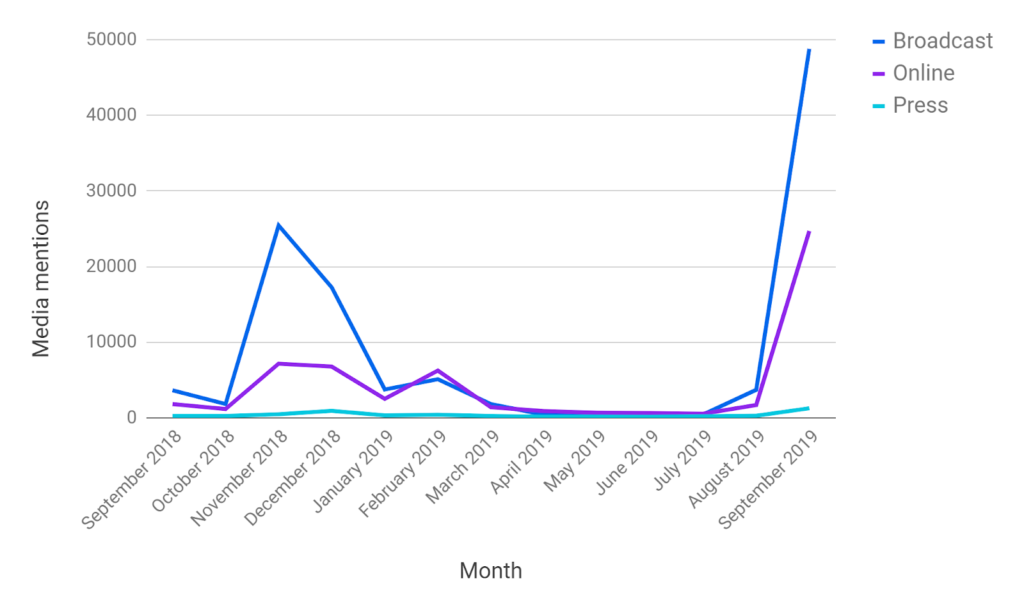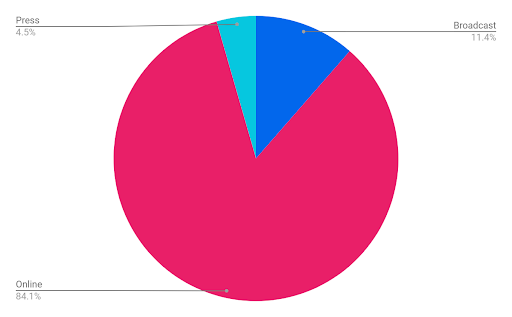Blog
The fundamentals of stakeholder strategy
A practical guide to tailored stakeholder management, offering strategies and tools to identify, map, and nurture relationships.
The early start of the bushfire season is being raised by the fire authorities as a serious concern. With another summer of record high temperatures still to come and no sign of the drought breaking, the bushfires have sparked the use of terms such as crisis, emergency, unprecedented and historic in the media. But bushfires in Queensland are not unusual and the subject of climate change being a contributor is also a hot topic.
In this blog, we delve deeper into these topics by analysing the media coverage around the Queensland bushfires and climate change.
In the past year, “bushfire,” “Queensland” and related keywords returned close to 174,000 mentions.
Throughout November and December 2018, we saw a spike in mentions predominantly across Broadcast. During this time, the media communicated great concern over an early start to the fire season and the lack of rain that was expected in the coming weeks and months.
Interestingly, the number of mentions from these months combined equates to less than the number of mentions that have happened in September 2019. These figures tell a story with emphasis being placed on the severity of the bushfires, the surrounding issues around climate change and the government’s response.

Queensland has been facing it’s most catastrophic bushfire season in recorded history – with more than fifty bushfires burning at one time. The Bureau of Meteorology’s data on climate change shows that rising temperatures have been evident since the beginning of the 20th century and have been gaining momentum with rising carbon emissions year on year.
This year, a warming climate has contributed to the early fire season. With an unusually dry winter, very little rainfall and above average temperatures, weather conditions like these have not been seen so early in Spring. Vegetation such as rainforests are now flammable thanks to a drier and hotter climate. These conditions are also putting more people at risk with health issues as well as fires threatening people’s homes.
The drought that’s now across much of the eastern seaboard has set the scene for more frequent and intense fires this summer. Currently, approximately 98 per cent of New South Wales and 65 per cent of Queensland are drought affected. Many towns in regional New South Wales and southern Queensland are having to get water supplies transported to them to avoid water shortages.
The warming climate has also increased the possibility of bushfires burning in different states simultaneously. Due to this, the paradigm to a strategic firefighting plan is required whereby states will need to resource their own fires as the resources aren’t available to lend a helping hand.
Despite the numerous bushfires that have happened in recent weeks, politicians have been insisting that climate change isn’t relevant to this year’s fire season.
Climate scientists advise this is a dangerous approach and Queensland’s summer of disasters is evidence that climate change will take an economic toll on taxpayers.
Bushfires and floods have been ravaging Queensland over the past three months and if natural disasters continue, the State Budget is estimated to take a hit of at least $1.5b.
The government has made disaster recovery payments available for eligible residents, where up to 13 weeks of income assistance can be claimed for those affected by natural disasters.
Strikes for climate change have been prominent on a global scale with ‘Strike for Climate’ rallies that have taken place in multiple cities around the world. The first rallies took place Friday 20th September 2019 and continued until Friday 27th September. During the week period, there were over 16,000 media mentions on the subject with 84 per cent of these mentions made online. These numbers depict just how prominent the subject of climate change is in the media.
In the below, we see the dispersion of mentions about the climate change strikes across Broadcast, Print and Online news.

These strikes were brought on after Swedish teenage activist, Greta Thunberg started to raise global awareness of the risks posed by climate change. She wanted to put pressure on politicians to be held accountable for their lack of action on the climate crisis.
Within Australia, hundreds of thousands of school students walked out of classrooms and rallied for action to be taken. The September strikes followed strikes that were held in March this year where over 150,000 people marched in Australia and 1.5million world wide.
Australia was one of the first countries in the world to join the global climate strike protests, with hundreds of thousands rallying in countries around the world. In capital cities around Australia, people prepared signs and chanted slogans in favour of swift climate action.
In Australia protesters want the Federal Government to commit to:
Looking to the future, it will be interesting to see how government bodies around the world respond to the rallies, to the changing climate and the effect they are having on the environment and community.
If you would like to learn more about the media coverage about this topic or anything media intelligence related, get in touch with us today.
Loren is an experienced marketing professional who translates data and insights using Isentia solutions into trends and research, bringing clients closer to the benefits of audience intelligence. Loren thrives on introducing the groundbreaking ways in which data and insights can help a brand or organisation, enabling them to exceed their strategic objectives and goals.
A practical guide to tailored stakeholder management, offering strategies and tools to identify, map, and nurture relationships.
Across the communications landscape, teams are being asked to do more with less, while staying aligned, responsive and compliant in the face of complex and often shifting stakeholder demands. In that environment, how we track, report and manage our relationships really matters. In too many organisations, relationship management is still built around tools designed for […]
Get in touch or request a demo.